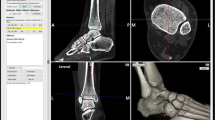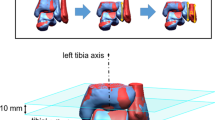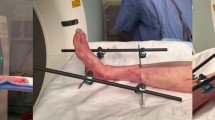Abstract
Purpose
The purpose of this study was to compare the reliability and accuracy of existing computed tomography (CT) methods for measuring the distal tibiofibular syndesmosis in uninjured, paired cadaveric specimens and in simulated malreduction models. It was hypothesized that a repeatable set of measurements exists to accurately and quantitatively describe the typical forms of syndesmotic malreduction using contralateral ankle comparison.
Methods
Twelve cadaveric lower-leg specimen pairs were imaged with CT to generate models for this study. Thirty-five measurements were performed on each native model. Next, four distinct fibular malreductions were produced via digital simulation and all measurements were repeated for each state: (1) 2-mm lateral translation; (2) 2-mm posterior translation; (3) 7-degree external rotation; (4) the previous three states combined. The modified standardized response mean (mSRM) was calculated for each measurement. To assess rater reliability and side-to-side agreements of the native state measurements, intraclass correlation coefficients (ICC) and Pearson correlation coefficients (PCC) were calculated, respectively.
Results
The most responsive measurements for detecting isolated malreduction were the Leporjärvi clear space for lateral translation, the Nault anterior tibiofibular distance for posterior translation, and the Nault talar dome angle for external rotation of the fibula. These measurements demonstrated fair to excellent inter-rater ICCs (0.64–0.76) and variable side-to-side PCCs (0.14–0.47).
Conclusions
The most reliable method to assess the syndesmosis on CT was to compare side-to-side differences using three distinct measurements, one for each type of fibular malreduction, allowing assessment of the magnitude and directionality of syndesmosis malreduction. Reliable evaluation is essential for assessing subtle syndesmosis injuries, malreduction and surgical planning.


Similar content being viewed by others
References
Ahn T-K, Choi S-M, Kim J-Y, Lee W-C (2017) Isolated syndesmosis diastasis: computed tomography scan assessment with arthroscopic correlation. Arthroscopy 33:828–834
Anand Prakash A (2017) Is incisura fibularis a reliable landmark for assessing syndesmotic stability? A systematic review of morphometric studies. Foot Ankle Spec 10:246–251
Bauer M, Jonsson K, Nilsson B (1985) Thirty-year follow-up of ankle fractures. Acta Orthop Scand 56:103–106
Clanton TO, Whitlow SR, Williams BT, Liechti DJ, Backus JD, Dornan GJ, Saroki AJ, Turnbull TL, LaPrade RF (2017) Biomechanical comparison of 3 current ankle syndesmosis repair techniques. Foot Ankle Int 38:200–207
Clanton TO, Williams BT, Backus JD, Dornan GJ, Liechti DJ, Whitlow SR, Saroki AJ, Turnbull TL, LaPrade RF (2017) Biomechanical analysis of the individual ligament contributions to syndesmotic stability. Foot Ankle Int 38:66–75
Cohen J (1988) Effect size. In: Statistical power analysis for the behavioral sciences, 2nd edn. Lawrence Erlbaum Associates, New Jersey, pp 21–23
Curtis MJ, Michelson JD, Urquhart MW, Byank RP, Jinnah RH (1992) Tibiotalar contact and fibular malunion in ankle fractures. A cadaver study. Acta Orthop Scand 63:326–329
Dattani R, Patnaik S, Kantak A, Srikanth B, Selvan TP (2008) Injuries to the tibiofibular syndesmosis. J Bone Jt Surg Br 90:405–410
Davidovitch RI, Weil Y, Karia R, Forman J, Looze C, Liebergall M, Egol K (2013) Intraoperative syndesmotic reduction: three-dimensional versus standard fluoroscopic imaging. J Bone Jt Surg Am 95:1838–1843
Dikos GD, Heisler J, Choplin RH, Weber TG (2012) Normal tibiofibular relationships at the syndesmosis on axial CT imaging. J Orthop Trauma 26:433–438
Ebinger T, Goetz J, Dolan L, Phisitkul P (2013) 3D model analysis of existing CT syndesmosis measurements. Iowa Orthop J 33:40–46
Ebraheim NA, Lu J, Yang H, Mekhail AO, Yeasting RA (1997) Radiographic and CT evaluation of tibiofibular syndesmotic diastasis: a cadaver study. Foot Ankle Int 18:693–698
Elgafy H, Semaan HB, Blessinger B, Wassef A, Ebraheim NA (2010) Computed tomography of normal distal tibiofibular syndesmosis. Skelet Radiol 39:559–564
Falissard B (2012) psy: various procedures used in psychometry. R Package Version 11
Fleiss JL (1981) Statistical methods for rates and proportions. Wiley, New York
Gardner MJ, Demetrakopoulos D, Briggs SM, Helfet DL, Lorich DG (2006) Malreduction of the tibiofibular syndesmosis in ankle fractures. Foot Ankle Int 27:788–792
Gifford PB, Lutz M (2014) The tibiofibular line: an anatomical feature to diagnose syndesmosis malposition. Foot Ankle Int 35:1181–1186
Horisberger M, Valderrabano V, Hintermann B (2009) Posttraumatic ankle osteoarthritis after ankle-related fractures. J Orthop Trauma 23:60–67
Hsu AR, Gross CE, Lee S (2013) Intraoperative O-arm computed tomography evaluation of syndesmotic reduction: case report. Foot Ankle Int 34:753–759
Hunt KJ, Goeb Y, Behn AW, Criswell B, Chou L (2015) Ankle joint contact loads and displacement with progressive syndesmotic injury. Foot Ankle Int 36:1095–1103
Kennedy JG, Johnson SM, Collins AL, DalloVedova P, McManus WF, Hynes DM, Walsh MG, Stephens MM (1998) An evaluation of the Weber classification of ankle fractures. Injury 29:577–580
Knops SP, Kohn MA, Hansen EN, Matityahu A, Marmor M (2013) Rotational malreduction of the syndesmosis: reliability and accuracy of computed tomography measurement methods. Foot Ankle Int 34:1403–1410
Leeds HC, Ehrlich MG (1984) Instability of the distal tibiofibular syndesmosis after bimalleolar and trimalleolar ankle fractures. J Bone Jt Surg Am 66:490–503
Lepojärvi S, Niinimäki J, Pakarinen H, Koskela L, Leskelä H-V (2016) Rotational dynamics of the talus in a normal tibiotalar joint as shown by weight-bearing computed tomography. J Bone Jt Surg Am 98:568–575
Lepojärvi S, Niinimäki J, Pakarinen H, Leskelä H-V (2016) Rotational dynamics of the normal distal tibiofibular joint with weight-bearing computed tomography. Foot Ankle Int 37:627–635
Lepojärvi S, Pakarinen H, Savola O, Haapea M, Sequeiros RB, Niinimäki J (2014) Posterior translation of the fibula may indicate malreduction: CT study of normal variation in uninjured ankles. J Orthop Trauma 28:205–209
Lindsjö U (1981) Operative treatment of ankle fractures. Acta Orthop Scand Suppl 189:1–131
Malhotra G, Cameron J, Toolan BC (2014) Diagnosing chronic diastasis of the syndesmosis: a novel measurement using computed tomography. Foot Ankle Int 35:483–488
Marmor M, Hansen E, Han HK, Buckley J, Matityahu A (2011) Limitations of standard fluoroscopy in detecting rotational malreduction of the syndesmosis in an ankle fracture model. Foot Ankle Int 32:616–622
McKinley TO, Rudert MJ, Tochigi Y, Pedersen DR, Koos DC, Baer TE, Brown TD (2006) Incongruity-dependent changes of contact stress rates in human cadaveric ankles. J Orthop Trauma 20:732–738
Mendelsohn ES, Hoshino CM, Harris TG, Zinar DM (2014) CT characterizing the anatomy of uninjured ankle syndesmosis. Orthopedics 37:e157–e160
Moody ML, Koeneman J, Hettinger E, Karpman RR (1992) The effects of fibular and talar displacement on joint contact areas about the ankle. Orthop Rev 21:741–744
Mukhopadhyay S, Metcalfe A, Guha AR, Mohanty K, Hemmadi S, Lyons K, O’Doherty D (2011) Malreduction of syndesmosis—are we considering the anatomical variation? Injury 42:1073–1076
Nault M-L, Hébert-Davies J, Laflamme G-Y, Leduc S (2013) CT scan assessment of the syndesmosis: a new reproducible method. J Orthop Trauma 27:638–641
Ovaska MT, Mäkinen TJ, Madanat R, Kiljunen V, Lindahl J (2014) A comprehensive analysis of patients with malreduced ankle fractures undergoing re-operation. Int Orthop 38:83
Pelton K, Thordarson DB, Barnwell J (2010) Open versus closed treatment of the fibula in Maissoneuve injuries. Foot Ankle Int 31:604–608
Pettrone FA, Gail M, Pee D, Fitzpatrick T, Van Herpe LB (1983) Quantitative criteria for prediction of the results after displaced fracture of the ankle. J Bone Jt Surg Am 65:667–677
Phisitkul P, Ebinger T, Goetz J, Vaseenon T, Marsh JL (2012) Forceps reduction of the syndesmosis in rotational ankle fractures: a cadaveric study. J Bone Jt Surg Am 94:2256–2261
Prior CP, Widnall JC, Rehman AK, Weller DM, Wood EV (2017) A simplified, validated protocol for measuring fibular reduction on ankle CT. Foot Ankle Surg 23:53–56
R Core Team (2017) R: a language and environment for statistical computing. Foundation for Statistical Computing, Vienna
Ramsey PL, Hamilton W (1976) Changes in tibiotalar area of contact caused by lateral talar shift. J Bone Jt Surg Am 58:356–357
Reb CW, Hyer CF, Collins CL, Fidler CM, Watson BC, Berlet GC (2016) Clinical adaptation of the “Tibiofibular Line” for intraoperative evaluation of open syndesmosis reduction accuracy: a cadaveric study. Foot Ankle Int 37:1243–1248
Richter M, Zech S (2009) Intraoperative 3-dimensional imaging in foot and ankle trauma-experience with a second-generation device (ARCADIS-3D). J Orthop Trauma 23:213–220
Sagi HC, Shah AR, Sanders RW (2012) The functional consequence of syndesmotic joint malreduction at a minimum 2-year follow-up. J Orthop Trauma 26:439–443
Schon JM, Mikula JD, Backus JD, Venderley MB, Dornan GJ, LaPrade RF, Clanton TO (2017) 3D model analysis of ankle flexion on anatomic reduction of a syndesmotic injury. Foot Ankle Int 38:436–442
Tang CW, Roidis N, Vaishnav S, Patel A, Thordarson DB (2003) Position of the distal fibular fragment in pronation and supination ankle fractures: a CT evaluation. Foot Ankle Int 24:561–566
Thordarson DB, Motamed S, Hedman T, Ebramzadeh E, Bakshian S (1997) The effect of fibular malreduction on contact pressures in an ankle fracture malunion model. J Bone Jt Surg Am 79:1809–1815
Tochigi Y, Rudert MJ, McKinley TO, Pedersen DR, Brown TD (2008) Correlation of dynamic cartilage contact stress aberrations with severity of instability in ankle incongruity. J Orthop Res 26:1186–1193
Vasarhelyi A, Lubitz J, Gierer P, Gradl G, Rösler K, Hopfenmüller W, Klaue K, Mittlmeier TWF (2006) Detection of fibular torsional deformities after surgery for ankle fractures with a novel CT method. Foot Ankle Int 27:1115–1121
van Vlijmen N, Denk K, van Kampen A, Jaarsma RL (2015) Long-term results after ankle syndesmosis injuries. Orthopedics 38:e1001–e1006
Weening B, Bhandari M (2005) Predictors of functional outcome following transsyndesmotic screw fixation of ankle fractures. J Orthop Trauma 19:102–108
Williams BT, Ahrberg AB, Goldsmith MT, Campbell KJ, Shirley L, Wijdicks CA, LaPrade RF, Clanton TO (2015) Ankle syndesmosis: a qualitative and quantitative anatomic analysis. Am J Sports Med 43:88–97
Williams BT, James EW, Jisa KA, Haytmanek CT, LaPrade RF, Clanton TO (2016) Radiographic identification of the primary structures of the ankle syndesmosis. Knee Surg Sports Traumatol Arthrosc 24:1187–1199
Wu G, Siegler S, Allard P, Kirtley C, Leardini A, Rosenbaum D, Whittle M, D’Lima DD, Cristofolini L, Witte H, Schmid O, Stokes I, Standardization and Terminology Committee of the International Society of Biomechanics (2002) ISB recommendation on definitions of joint coordinate system of various joints for the reporting of human joint motion–part I: ankle, hip, and spine. Int Soc Biomech J Biomech 35:543–548
Zwipp H (1994) Chirurgie des Fußes (Surgery of the Foot). Springer-Verlag, Wien, New York
Funding
This study was funded internally by the Steadman Philippon Research Institute.
Author information
Authors and Affiliations
Corresponding author
Ethics declarations
Conflict of interest
The authors have no potential conflicts of interest to disclose.
Ethical approval
Institutional review board approval was not required because deidentified cadaveric specimens are exempt from review at our institution.
Additional information
Publisher’s Note
Springer Nature remains neutral with regard to jurisdictional claims in published maps and institutional affiliations.
Investigation performed at the Department of BioMedical Engineering, Steadman Philippon Research Institute, Vail, Colorado.
Appendix
Rights and permissions
About this article
Cite this article
Schon, J.M., Brady, A.W., Krob, J.J. et al. Defining the three most responsive and specific CT measurements of ankle syndesmotic malreduction. Knee Surg Sports Traumatol Arthrosc 27, 2863–2876 (2019). https://doi.org/10.1007/s00167-019-05457-8
Received:
Accepted:
Published:
Issue Date:
DOI: https://doi.org/10.1007/s00167-019-05457-8




